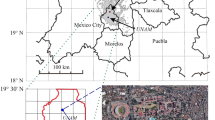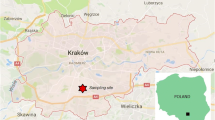Abstract
In order to do source apportionment of PM2.5 and source trajectories, particle induced X-ray emission and energy disperse-X ray fluorescence were used to analyze chemical composition of samples. Five major sources have been identified by using positive matrix factorization. Source trajectories have been determined by conditional probability function and the potential source contribution function. Extreme events, such as sandstorms, have been identified and traced.






Similar content being viewed by others
References
Ito K, Christensen WF, Eatough DJ, Henry RC, Kim E, Laden F, Lall R, Larson TV, Neas L, Hopke PK (2005) PM source apportionment and health effects: 2. An investigation of intermethod variability in associations between source-apportioned fine particle mass and daily mortality in Washington, DC. J Expo Sci Environ Epidemiol 16(4):300–310
Schwartz J, Dockery DW (1992) Increased mortality in Philadelphia associated with daily air pollution concentrations. Am Rev Respir Dis 145(3):600–604
Davidson CI, Phalen RF, Solomon PA (2005) Airborne particulate matter and human health: a review. Aerosol Sci Technol 39(8):737–749
Seinfeld JH, Pandis SN (2012) Atmospheric chemistry and physics: from air pollution to climate change. Wiley, New York
Buseck PR, Pósfai M (1999) Airborne minerals and related aerosol particles: effects on climate and the environment. Proc Natl Acad Sci 96(7):3372–3379
Mathers C, Stevens G, Mascarenhas M (2009) Global health risks: mortality and burden of disease attributable to selected major risks. World Health Organization, Geneva
Almeida S, Pio C, Freitas M, Reis M, Trancoso M (2005) Source apportionment of fine and coarse particulate matter in a sub-urban area at the Western European Coast. Atmos Environ 39(17):3127–3138
Kothai P, Saradhi I, Pandit G, Markwitz A, Puranik V (2011) Chemical characterization and source identification of particulate matter at an urban site of Navi Mumbai, India. Aerosol Air Qual Res 11(5):560–569
Kyotani T, Iwatsuki M (2002) Characterization of soluble and insoluble components in PM2.5 and PM10 fractions of airborne particulate matter in Kofu city, Japan. Atmos Environ 36(4):639–649
Mazzei F, D’Alessandro A, Lucarelli F, Nava S, Prati P, Valli G, Vecchi R (2008) Characterization of particulate matter sources in an urban environment. Sci Total Environ 401(1):81–89
Sánchez-Ccoyllo OR, Ynoue RY, Martins LD, Astolfo R, Miranda RM, Freitas ED, Borges AS, Fornaro A, Freitas H, Moreira A (2009) Vehicular particulate matter emissions in road tunnels in Sao Paulo, Brazil. Environ Monit Assess 149(1–4):241–249
Vecchi R, Marcazzan G, Valli G, Ceriani M, Antoniazzi C (2004) The role of atmospheric dispersion in the seasonal variation of PM1 and PM2.5 concentration and composition in the urban area of Milan (Italy). Atmos Environ 38(27):4437–4446
Wu Y, Hao J, Fu L, Hu J, Wang Z, Tang U (2003) Chemical characteristics of airborne particulate matter near major roads and at background locations in Macao, China. Science Total Environ 317(1):159–172
Xiao C, Zhang G, Huang D, Ni B, Liu C, Qin Y, Sun H, Wang P, Tian W (2012) Preliminary study on air pollution source identification in Xinzhen, Beijing, using NAA and PIXE. J Radioanal Nucl Chem 291(1):95–100
Paatero P (1997) Least squares formulation of robust non-negative factor analysis. Chemom Intell Lab Syst 37(1):23–35
Paatero P, Tapper U (1994) Positive matrix factorization: a non-negative factor model with optimal utilization of error estimates of data values. Environmetrics. 5(2):111–126
Amato F, Hopke PK (2012) Source apportionment of the ambient PM2.5 across St. Louis using constrained positive matrix factorization. Atmos Environ 46:329–337
Kim E, Hopke PK, Edgerton ES (2004) Improving source identification of Atlanta aerosol using temperature resolved carbon fractions in positive matrix factorization. Atmos Environ 38(20):3349–3362
Lee E, Chan CK, Paatero P (1999) Application of positive matrix factorization in source apportionment of particulate pollutants in Hong Kong. Atmos Environ 33(19):3201–3212
Kim E, Hopke PK, Edgerton ES (2003) Source identification of Atlanta aerosol by positive matrix factorization. J Air Waste Manag Assoc 53(6):731–739
Choi JK, Heo JB, Ban SJ, Yi SM, Zoh KD (2013) Source apportionment of PM2.5 at the coastal area in Korea. Sci Total Environ 447:370–380
Cohen DD, Crawford J, Stelcer E, Atanacio AJ (2012) Application of positive matrix factorization, multi-linear engine and back trajectory techniques to the quantification of coal-fired power station pollution in metropolitan Sydney. Atmos Environ 61:204–211
Campbell JL, Boyd NI, Grassi N, Bonnick P, Maxwell JA (2010) The Guelph PIXE software package IV. Nucl Instrum Methods Phys Res Sect B 268(20):3356–3363
Malm WC, Sisler JF, Huffman D, Eldred RA, Cahill TA (1994) Spatial and seasonal trends in particle concentration and optical extinction in the United States. J Geophys Res 99(D1):1347–1370
Tolgyessy J (1993) Chemistry and biology of water, air and soil: environmental aspects, vol 53., Studies in environmental scienceElsevier, Amsterdam
Gildemeister AE, Hopke PK, Kim E (2007) Sources of fine urban particulate matter in Detroit, MI. Chemosphere 69(7):1064–1074
Acknowledgments
This work has been supported in part by IAEA RCA RAS/7/023. Beijing Normal University, Australian Nuclear Science and Technology Organization and The National University of Mongolia have performed the elemental analysis of APM filters, and we are grateful for that. National Oceanic and Atmospheric Administration (NOAA) Air Resources Laboratory (ARL) is appreciated that they made available the HYSPLIT model and meteorology data files.
Author information
Authors and Affiliations
Corresponding author
Rights and permissions
About this article
Cite this article
Jin, X., Xiao, C., Li, J. et al. Source apportionment of PM2.5 in Beijing using positive matrix factorization. J Radioanal Nucl Chem 307, 2147–2154 (2016). https://doi.org/10.1007/s10967-015-4544-0
Received:
Published:
Issue Date:
DOI: https://doi.org/10.1007/s10967-015-4544-0




